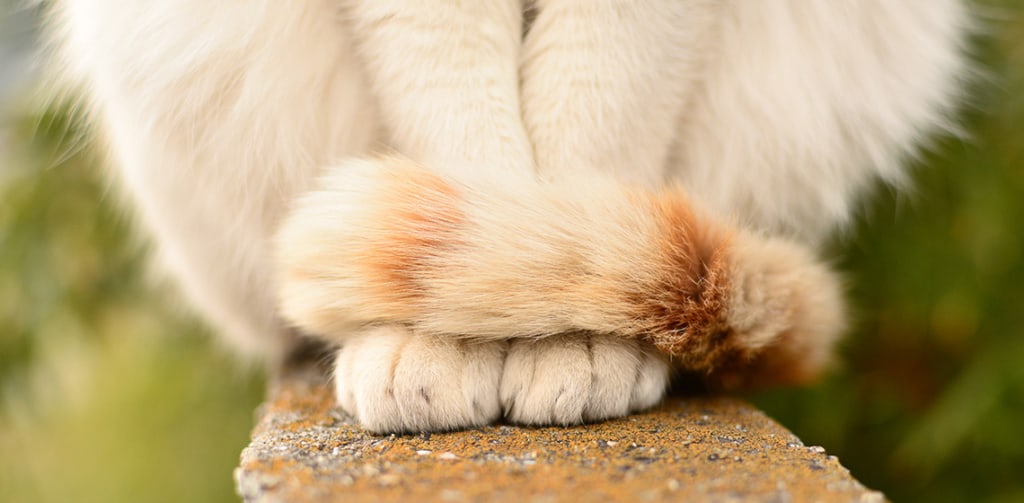Contrary to popular belief, cats are not antisocial creatures. Instead, they are asocial. This means that they do not need to socialize in the way that humans or dogs do, but they can enjoy it when it happens on their terms. As pet parents, we must respect our cats’ independent natures, and learn to understand when they want our affection and when they would rather be left alone.
Table of Contents
Our cats’ tails can help to provide us with an insight into their mood and can let us know whether they are seeking out a snuggle, or would prefer to be left alone for some quiet contemplation.
If your cat is wanting to be affectionate, then they will approach you with an upright tail.
Upright Tails
An upright tail is generally the sign of a happy, relaxed cat. They will often raise their tail in greetings to other cats or humans in their family. Sometimes the tip of the tail may bend forward, or there may be a gentle curve as the tail rises.
A cat who is approaching you with an upright tail is generally relaxed and friendly, and may well be looking for some affection. Offer them a gentle rub around the head or under the chin and see how they respond. If they return the affection, then that’s the signal to continue stroking them!
Twined Tails
A cat who is being affectionate, or who is wanting something from a human, will often rub themselves around our legs. As they do this, their tail may wrap around our legs. This may be a sign that your cat wants affection, but they may also be seeking something else from you – often their dinner!
Two friendly cats who are walking side by side may also intertwine their tails as they walk. This is a sign of affection – only cats who are very fond of each other will do this kind of tail twining.
If your cat’s tail is tapping, then this is a sign that they are busy and do not wish to be disturbed.
Tail Between The Legs
Sometimes cats may sit with their tail wrapped around themselves, or even tucked up underneath their body. They may do this to keep themselves warm in cold weather, but also to comfort themselves. Cats who are stressed, sick, or in pain will often curl up in a tight ball with their tail either tightly around them, or underneath. You might also notice that they do this when they are sitting or crouching.
Cats who are curled up tight like this usually do not want human affection, as this may cause them to feel more stressed, or they may worry that your stroking will cause them pain.
If your cat starts to sit in these kinds of positions more regularly than they used to, then you should see your veterinarian for advice.
Tapping Tail Tips
If your cat is sitting with their tail out to one side of their body, then occasionally you might notice that the tip is tapping up and down on the ground, or gently flicking backwards and forwards. Only the very end of the tail will do this – if most or all of the tail is moving, then this would count as a “swishing tail” (see below).
Cats whose tails are tapping are usually concentrating hard on whatever it is that they are looking at. Sometimes they will not stare directly at the object of interest but will look near it instead, or give it the side-eye.
If your cat’s tail is tapping, then this is a sign that they are busy and do not wish to be disturbed. You should leave them to their activity, and come back later to see if they are more interested in some fuss.
If your cat’s tail is whipping from side to side, there is something around that is making them unhappy. If this is a small child or another pet, then you should quickly separate them to prevent injury.
Swishing Tails
A cat with a swishing tail is usually one who wants to be left alone.
Slower, gentler sweeps of the tail may be seen in cats who are intently concentrating on something. This might be a toy, another cat, or even another human. Whatever they are considering, it is best to leave them alone to think. They don’t want to be interrupted.
Large, sudden lashes of the tail are a strong sign that a cat is unhappy. In the wild, cats do this when they see other cats, as a way to appear large and threatening and to try and drive off their rivals.
If your cat’s tail is whipping from side to side, then their gaze will usually be fixed on whatever is making them unhappy. If this is a small child or another pet, then you should quickly separate them to prevent injury. Try to take whatever is stressing the cat away so that they can no longer see it.
Treat a lashing tail as a warning sign!
However, you must be very wary of cats whose tails are lashing around like this. If you try and intervene, there is a risk that they might think you are dangerous, and end up attacking you instead.
Given that these sudden lashes show that our cats are upset, it might be tempting to try and comfort them. However, if your cat is in this agitated state, they will almost certainly not enjoy physical contact with you, and it is very unlikely to make them feel better. Indeed, they might mistake your affection for aggression, and lash out at you instead. Do not attempt to stroke or pick up cats in this state.
Conclusion
Our cats’ tails can be an important way for us to understand what our cats are thinking or feeling, and can help us to know whether or not they are interested in having a fuss. Sometimes their tails can also tell us that they are angry, sick, or stressed.
We should always pay attention to our cats’ behavior, and make sure that we respect their feelings on whether or not they want our affection.
FAQ
A cat’s tail can give you a lot of information about what they are thinking or feeling. Different tail movements can suggest interest, concentration, or sometimes aggression. Our cats’ tails can also sometimes tell us if our cats are feeling unwell.
If your cat is wanting to be affectionate, then they will approach you with an upright tail, which may bend gently in the middle or flop over slightly at the top. If you are unsure, then it is best to let your cat initiate affection. You can let them come to you, or offer them your hand to sniff. If they rub up against it, then this is a sign of affection.
If your cat’s tail is flicking when you stroke them, then this may be a sign that they are not enjoying their fuss. Cats can be quite picky about when they want to be stroked, and it is important to always respect their boundaries. We should always let our cats initiate fuss.
Our cats will sometimes come to twine themselves around our legs and may hit us with their tails as they do so. They are not deliberately hitting us – instead, this is a sign of affection, or that they want something from us.
However, if your cat is swishing their tail backwards and forwards in large movements, then this means that they are unhappy about something. They are not deliberately trying to hit you, but it is their way of telling you that they are upset or angry. Try to work out what is making them unhappy – sometimes it may be the fact that you are stroking or holding them.

Ruth graduated from Cambridge in 2014 and has worked as a small animal GP vet ever since. She is particularly interested in internal medicine, as it combines her love of problem-solving and her somewhat geeky love of knowledge, and has completed her certificate in Small Animal Medicine. She loves animals of all species but is particularly fond of cats.








